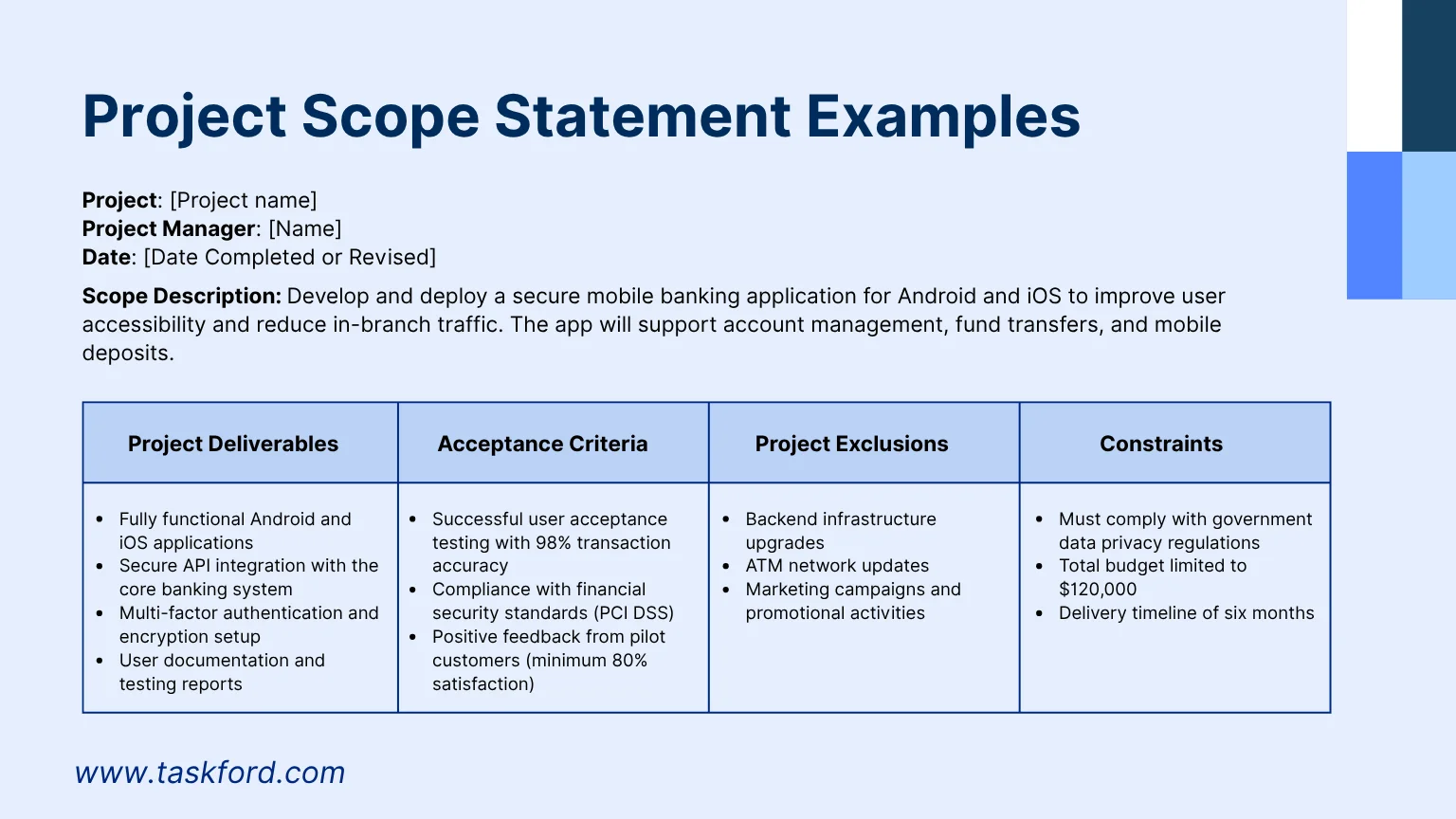What Is a Project Scope Statement: 5 Examples for Different Industries
Learn what a project scope statement is, how to write one, and explore 5 detailed examples from industries like IT, construction, marketing, and healthcare.
A well-defined project scope statement is one of the first steps toward a successful project. It outlines what the project will deliver, what it won’t, and the boundaries that keep teams aligned from start to finish. Without a clear scope, even the best-managed projects risk confusion, missed deadlines, and unexpected costs.
In this guide, we’ll explain what a project scope statement is, its importance, and show you 5 real-world examples across different industries, from construction and marketing to software development and healthcare. You’ll also learn how to write your own scope statement using a proven structure that helps teams stay focused and stakeholders stay informed.
Whether you’re managing your first project or refining your organization’s workflow, this article will help you understand how a strong scope statement supports smoother execution, accurate planning, and better results.
Learn more:What Is Scope in Project Management
What Is a Project Scope Statement?

A project scope statement is a foundational document that clearly defines the objectives, deliverables, and boundaries of a project. It acts as a formal agreement between the project team and stakeholders, ensuring everyone understands what the project will achieve, and just as importantly, what falls outside its scope.
In simple terms, the project scope statement answers three key questions:
- What needs to be done? (goals and deliverables)
- How will it be done? (approach, resources, and timeline)
- What are the limits? (inclusions, exclusions, and constraints)
A clear project scope statement is more than a formality; it’s a tool for alignment and accountability. When every stakeholder understands the project’s purpose, boundaries, and expected outcomes, it becomes much easier to keep the work on track.
By addressing these questions upfront, project managers can prevent confusion and maintain control throughout the project lifecycle.
How to Write a Project Scope Statement (Step-by-Step)

Writing a project scope statement doesn’t have to be complicated. The key is to capture the project’s purpose, direction, and expectations clearly so everyone involved understands what success looks like. Follow these six steps to create a scope statement that sets your project up for success.
Step 1: Define Project Objectives
Start by outlining _why the project exists _and what it aims to accomplish. Well-defined objectives guide all decisions and keep the team focused. Use SMART goals (specific, measurable, achievable, relevant, and time-bound) to make your objectives actionable.
Step 2: Identify Key Deliverables
List the main outputs your project will produce. These could be a completed product, report, marketing campaign, or event. Clear deliverables help stakeholders understand exactly what will be delivered and serve as a foundation for tracking progress.
Step 3: Set Clear Boundaries and Exclusions
Define project scope, what’s in scope, and what’s out of scope. This prevents confusion and avoids additional requests that can delay or derail the project. The clearer your boundaries, the easier it is to manage expectations and control scope changes.
Step 4: List Key Stakeholders and Roles
Identify the individuals or groups involved in the project, such as clients, sponsors, and team members, and specify their responsibilities. Assigning clear roles early improves communication and ensures accountability throughout the project.
Step 5: Establish Milestones and Deadlines
Map out important phases, milestones, and target dates. A detailed timeline helps track progress, coordinate resources, and maintain momentum. Project management tools make it easy to visualize milestones and monitor deliverables in real time.
Step 6: Validate Assumptions and Get Approvals
List any assumptions or constraints that may affect project success, such as budget limits, resource availability, or client dependencies. Then, obtain formal stakeholder approval of the scope statement. This sign-off confirms alignment before work begins and provides a reference point for any future changes.
5 Project Scope Statement Examples for Different Industries

Every industry has its own challenges, goals, and success measures. A well-crafted project scope statement adapts to these unique needs while maintaining clarity and structure. Below are ten examples showing how different sectors define their scope to keep projects focused and on track.
1. IT and Software Development Project Scope Statement Example
Project: Mobile Banking Application Development Project Manager: [Name] Date: [Date Completed or Revised]
Scope Description: Develop and deploy a secure mobile banking application for Android and iOS to improve user accessibility and reduce in-branch traffic. The app will support account management, fund transfers, and mobile deposits.
Project Deliverables:
- Fully functional Android and iOS applications
- Secure API integration with the core banking system
- Multi-factor authentication and encryption setup
- User documentation and testing reports
Acceptance Criteria:
- Successful user acceptance testing with 98% transaction accuracy
- Compliance with financial security standards (PCI DSS)
- Positive feedback from pilot customers (minimum 80% satisfaction)
Project Exclusions:
- Backend infrastructure upgrades
- ATM network updates
- Marketing campaigns and promotional activities
Constraints:
- Must comply with government data privacy regulations
- Total budget limited to $120,000
- Delivery timeline of six months
2. Construction Project Scope Statement Example
Project: Two-Story Residential Home Construction Project Manager: [Name] Date: [Date Completed or Revised]
Scope Description: Build a two-story, energy-efficient family home using sustainable materials in accordance with local building codes and environmental standards.
Project Deliverables:
- Architectural design and permits
- Completed foundation, framing, plumbing, and electrical systems
- Energy-efficient roofing and insulation
- Final inspection and certification
Acceptance Criteria:
- Compliance with all safety and environmental regulations
- Completion within 12 months
- No variance exceeding 5% of the proposed budget
Project Exclusions:
- Landscaping and interior decoration
- Furniture installation
- Post-construction maintenance
Constraints:
- Budget cap of $400,000
- Weather delays may impact progress
- Limited contractor availability during peak seasons
3. Marketing Campaign Project Scope Statement Example
Project: New Product Digital Launch Project Manager: [Name] Date: [Date Completed or Revised]
Scope Description: Plan and execute a digital campaign to launch a new skincare line. The campaign will focus on social media, influencer partnerships, and email marketing.
Project Deliverables:
- 3-month campaign calendar
- Creative ad designs and landing pages
- Influencer collaboration agreements
- Campaign performance reports
Acceptance Criteria:
- Achieve a 20% engagement increase on target channels
- Generate 5,000 new leads during the campaign period
- Ad click-through rate (CTR) above 3%
Project Exclusions:
- Product photography
- Video production
- Offline marketing events
Constraints:
- Campaign budget of $30,000
- Must align with brand compliance standards
- Limited ad inventory availability during launch week
4. Event Management Project Scope Statement Example
Project: Corporate Leadership Conference Project Manager: [Name] Date: [Date Completed or Revised]
Scope Description: Organize a two-day leadership summit for 500 participants to promote professional networking and knowledge sharing among executives.
Project Deliverables:
- Venue booking and catering arrangements
- Event registration and ticketing system
- Logistics, security, and audio-visual setup
- Event signage and digital marketing collateral
Acceptance Criteria:
- 95% on-time task completion rate
- Participant satisfaction rating above 85%
- Compliance with venue safety standards
Project Exclusions:
- Speaker compensation
- Post-event media production
- Travel arrangements for attendees
Constraints:
- Total budget capped at $90,000
- Must secure venue by the end of Q1
- Limited vendor availability during conference season
5. Healthcare Project Scope Statement Example
Project: Electronic Medical Records (EMR) Implementation Project Manager: [Name] Date: [Date Completed or Revised]
Scope Description: Implement a hospital-wide EMR system to replace manual records, improve patient data accuracy, and streamline communication among medical departments.
Project Deliverables:
- EMR software setup and configuration
- Data migration from existing systems
- Staff training sessions
- Compliance audit documentation
Acceptance Criteria:
- Full system functionality with 99% uptime
- Successful migration of 100% patient records
- Completion of HIPAA compliance certification
Project Exclusions:
- Hardware purchases
- Integration with external laboratories
- Custom patient apps (future phase)
Constraints:
- Budget limited to $200,000
- Implementation period of 9 months
- Staff training hours must not affect clinical operations
Across industries, whether in software development, construction, marketing, or healthcare, a well-defined project scope statement is a key factor in project success. Research published on ResearchGate shows that poor scope definition is one of the primary causes of project failure, often leading to cost overruns, missed deadlines, and stakeholder misalignment. Regardless of the industry, the pattern remains consistent: a clear scope statement establishes what the project will accomplish, what falls outside its boundaries, and how success will be measured. This clarity reduces uncertainty, strengthens communication, and significantly minimizes the risk of scope creep throughout the project lifecycle.
Conclusion
A clear and complete project scope statement is the foundation of any successful project. It defines what needs to be done, aligns every stakeholder around shared goals, and keeps projects within budget, schedule, and purpose. Whether you’re building software, planning an event, or managing construction, documenting your project’s scope ensures there’s no confusion about deliverables or expectations.
The examples above show how different industries use scope statements to maintain focus and accountability. By following the step-by-step process - defining objectives, deliverables, boundaries, and constraints - you can create a scope statement that sets your team up for success from day one.
Making work simpler,
smarter, and more connected
Join our waitlist and be notified first.

Related Blog
Subscribe for Expert Tips
Unlock expert insights and stay ahead with TaskFord. Sign up now to receive valuable tips, strategies, and updates directly in your inbox.






